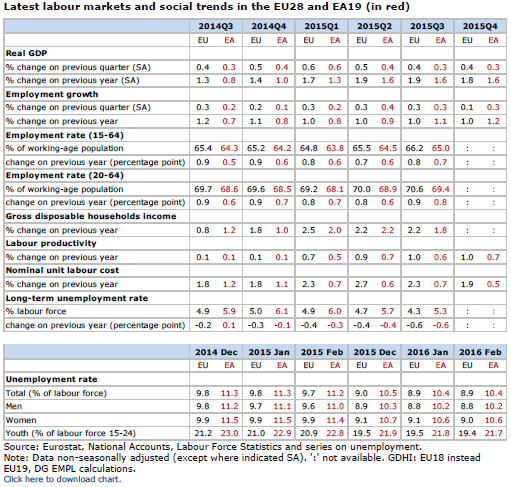
Employment and Social Situation Improve in Europe says EU
Employment and Social Affairs 13 April 2016The latest edition of the EU’s Employment and Social Situation Quarterly Review highlights how activity rate in the EU has continued its stable increase since 2008 – especially for older people, though not yet for younger people.
EU’s economy continues its slow but consistent recovery, with a gradual increase in the employment rate and a gradual decline in the unemployment rate, the European Commission highlights in its Quarterly Review on Employment.
Even if the economic and labour market recovery has not been particularly strong for some Member States, these developments are a sign of general economic and employment growth in most EU countries, the Commission stresses.
“The activity rate in the EU has continued its steady increase since 2008, in particular for older people, though not yet for younger people”, underlines the Employment and Social Situation Quarterly Review.
Employment rate has returned to its pre-crisis level
Even though at a slower pace than in 2014, permanent and full-time jobs are more and more increasing.
Employment rate has returned to its pre-crisis level, but the gap between countries is much wider, from 55% in Greece to 80% in Estonia, Germany and Sweden.
Unemployment continued to recede with 4.9 million fewer unemployed people since the April 2013 peak, but nearly 5 million more people unemployed in February 2016 than in March 2008.
The financial situation of EU households is also improving. There is more available income in nearly all Member States, though households with the lower income remains in high financial distress.
For more information on the current situation of the European Union’s economy, read “TOWARDS GRADUAL RECOVERY.”
An Encouraging Sign in View of the Ageing of European Population
Published today, the latest edition of the EU Employment and Social Situation – Spring 2016 Quarterly Review aims to better understand the gradual labour market recovery by looking at the evolution of activity rates (or labour market participation) of different age groups.
Conversely to the US, the EU activity rate – namely those in employment or looking for work – has increased steady since 2008, even during the recent and severe crisis.
- Labour market participation of those aged 15-64 was 72.8% of the total population 15-64 in the third quarter of 2015. This increase is mainly due to an increase in activity rates of older age groups notably those aged 55-64.
- The activity rate of those aged 55-59 has almost reached the overall 15-64 (working age) activity rate now.
- The activity rate of those aged 60-64 has also increased and is now very close to the activity rate of young people aged 15 – 24 years for the first time in decades.
This is developments are important in view of population ageing, even if activity rates differ considerably across Member States – from less than 65% in Italy to more than 80% in Sweden.

Source: EU Employment and Social Situation – Spring 2016 Quarterly Review
“The increase in activity rates, notably of older age groups, is an encouraging sign in view of the ageing of European population. But we need to ensure that this growing number of people who are willing to work are well integrated into our labour markets. Skills are key to this. The new Skills Agenda for Europe that we will present in the coming weeks should make a major contribution to transforming higher activity rates into more high-quality jobs,” Commissioner for Employment, Social Affairs, Skills and Labour Mobility Marianne Thyssen observed.


